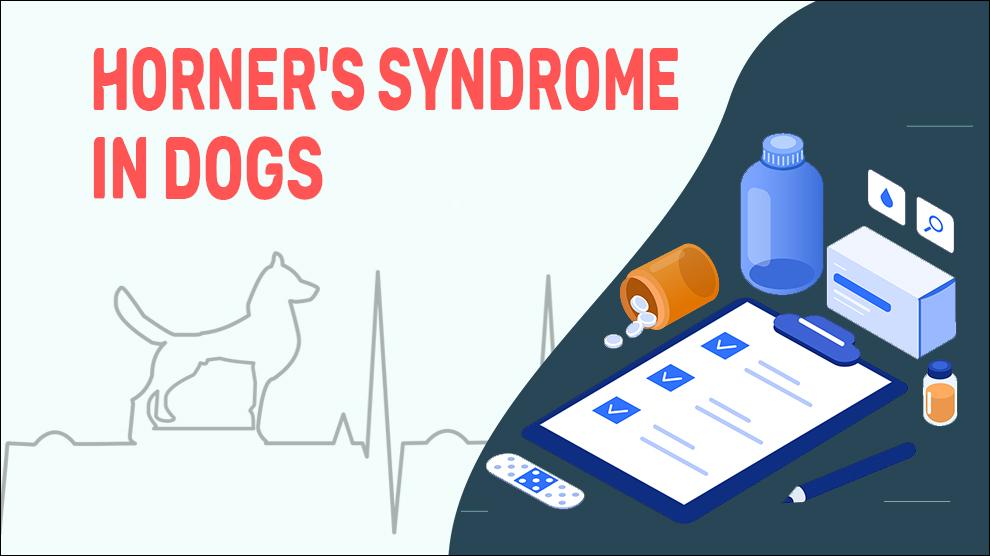What Is Horner’s Syndrome In Dogs?
Horner's syndrome is a myriad of symptoms due to neurological insufficiencies of the facial muscles and eye arising from the malfunction of the oculosympathetic pathway.
This syndrome is characterized by enophthalmos, miosis, ptosis, and the third eyelid. It has been recognized in several breeds and ages but most are 5-8 years of age. Also called oculosympathetic palsy or Bernard-Horner syndrome, Horner's syndrome usually involves diseases in the brainstem and only affects one eye as both eyes getting affected is very rare.
The oculosympathetic pathway (OSP) is a long, circuitous 3-neuron pathway. The first order/central neuron originate from the hypothalamus and travels through the brainstem, reaching the lateral funiculus of the spinal cord. The second-order/preganglionic neuron arises from the first 3 thoracic spinal cord segments within the intermediolateral horn of the gray matter and travels through the cervical region and thorax and terminates at the cranial cervical ganglion where it with the postganglionic/third-order neuron cell body. Passing through the tympanic bulla, the third-order/postganglionic neuron via the orbital fissure extends to the orbit.
Horner's syndrome results from any disorder in the oculosympathetic pathway. Brainstem ischemia is the major reason for First-order Horner's syndrome. Second-order lesions may be due to Lung masses (Pancoast tumors). Third-order Horner's syndrome is most often associated with vascular headache syndromes, cavernous sinus lesions, and internal carotid artery dissection.
Symptoms Of Horner’s Syndrome In Dogs
- Ptosis - Drooping of the upper eyelid on the affected eye.
- Miosis - Constricted pupil.
- Enophthalmos - Sunken appearance of the affected eye.
- Elevated third eyelid.
- Impaired Vision.
Treatment Options For Horner’s Syndrome In Dogs
There is no specific cure for horner’s syndrome but it can be treated to relieve symptoms. Vets may recommend one or a combination of these treatments based on underlying causes:
Treatment of diseases of infectious origin: Antibiotics, Antivirals, Antiparasitics, etc.
Treatment of diseases of tumor origin: Surgery, Chemotherapy.
Treatment of inflammatory or immune-mediated diseases: Immunosuppressive drugs.
Home Remedies For Horner’s Syndrome In Dogs
Check with your veterinarian to give you a better understanding of the damage that happened and if any, underlying condition has been found, discuss a treatment plan to be put in place.
How To Prevent Horner’s Syndrome In Dogs?
Diet: Wholesome, nutritionally balanced diet formulated for the dog’s age, built, and lifestyle.
Weight: The tendency to gain excess body weight is most commonly seen in middle-aged dogs between the ages of 5 -10.
Exercise: Promoting regular exercise to maintain or achieve the ideal weight for the dog.
Supplements: Eye, bone, and nerve supplements.
Affected Dog Breeds Of Horner’s Syndrome
Golden Retriever, Collie, Doberman Pinscher, Labrador Retriever, Shetland Sheepdog, Weimaraner
Causes And Types For Horner’s Syndrome In Dogs
- Causes:
- Idiopathic - When the actual trigger is unknown.
- Spinal cord tumor
- Cancer of the nerves along the pathway.
- Trauma
- Brain tumor
- Inner ear infection
- Neuropathy, such as hypothyroidism.
- Types:
First Order / Central Lesion:
Trauma, brain tumors, spinal cord tumors, or blood clots can be the reason for damage to this site. Additional neurological signs such as head tilting or stumbling may also present.
Second-Order / Preganglionic Lesion:
Damage to nerves between the spinal cord and the neuronal junction will be the cause. For example, tumors in the chest or neck or Trauma to the neck.
Postganglionic Lesion:
Damage to the nerve between the neuronal junction and the orbit causes this lesion. They are mostly idiopathic but can also occur when the dog has tympanic cavity diseases.
- Morbidity:
There are different causes of horner’s syndrome and they can vary in terms of breeds they affect, what their symptoms are and which locations they affect. Nonetheless, whatever the type of syndrome is, it often progresses and worsens - this means, that the longer the duration of the condition in dogs, the muscles get progressively weaker.
- Mortality:
Horner’s syndrome is not potentially life-threatening and there is no documented mortality.
- Diagnosis:
- Nerve biopsy
- Biochemical and genetic testing.
- CT scan and MRI
- Lumbar puncture (spinal tap).
- Nerve conduction studies and electromyography (EMG).
- Prognosis:
In most cases, Horner’s syndrome carries a favorable prognosis, although they are a difficult group of disease to manage. Most commonly, they will resolve on their own. However, treatment of the underlying conditions may be required. In cases of idiopathic Horner’s syndrome, recovery will typically occur within 4 to 6 months.
When To See A Vet For Horner’s Syndrome In Dogs?
Contact your vet right away, if you notice any of the following:
- Ptosis - Drooping of the upper eyelid on the affected eye.
- Miosis - Constricted pupil.
- Enophthalmos - Sunken appearance of the affected eye.
Food Suggestions For Horner’s Syndrome In Dogs
Vitamins A, C, omega 3s, carotenoids, beta-carotene, zinc, antioxidants, and lycopene should be included in the diet.
- Leafy greens such as spinach, kale, cabbage, etc.
- Nonmeat/plant protein sources such as Chickpeas, Peanuts, Lentils, Soybeans, Eggs, etc.
- Omega-3 oily fishes such as mackerel, tuna, cod, salmon, etc.
- Citrus fruits or juices, Sweet potatoes, tomatoes, pumpkin.
- Zinc foods such as Pork, tuna, and Oysters.
- Blueberries, Broccoli, Beef liver, carrots, etc.
Conclusion
The underlying condition (if any) and location of the damage have a huge impact on recovery duration. When the damage is for an unknown reason, it is better to leave the syndrome alone to heal on its own. Based on the severity of the symptoms, this can take anywhere from 4 to 6 months.

















